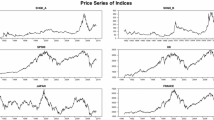Abstract
Since the Asian financial crisis and the global financial crisis, the regime shift behavior has been notable in the stock markets. We examine the effects of interest rates and foreign exchange rates on stock returns and the cross-correlations of Korean stock returns associated with three other countries: Japan, USA, and China, using the Hamilton 2-regime Markov Switching model, for the period January 1993–December 2016. In both regimes, the volatility in the Korean stock market is greater than Japan and USA, but less than China. In regime 1 with low-volatility, the stock returns of both Korea and Japan are significantly affected first by their exchange rates and then by their interest rates. In regime 2 with high-volatility, the Korean stock market is explained by neither of the two exogenous variables while the Japanese stock returns respond positively to the exchange rates but negatively to the interest rates. The transition probability from regime 1 to regime 2 is greater than the reverse probability in the Korean stock market, which is opposite in Japan. Considering all four countries simultaneously, the Korean stock market is highly influenced by both the US and Japanese stock market in regime 1 with low-volatility, but only influenced by the Japanese stock market in regime 2 with high-volatility.



Similar content being viewed by others
References
Hamilton, J.D.: A new approach to the economic analysis of nonstationary time series and the business cycle. Econometrica 57, 357–384 (1989)
Schaller, H., Norden, S.V.: Regime switching in stock market returns. Appl. Financ. Econ. 7(2), 177–191 (1997)
Nishiyama, K.: Some evidence of regime shifts in international stock markets. Manag. Financ. 24, 30–55 (1998)
Hamilton, J.D., Susmel, R.: Autoregressive conditional heteroscedasticity and changes in regime. J. Econom. 64, 307–333 (1994)
Cai, J.: A Markov model of unconditional variance in ARCH. J. Bus. Econ. Stat. 12, 309–316 (1994)
Maheu, J.M., McCurdy, T.H.: Identifying bull and bear markets in stock returns. J. Bus. Econ. Stat. 18, 100–112 (2000)
Guidolin, M., Timmermann, A.: An econometric model of nonlinear dynamics in the joint distribution of stock and bond returns. J. Appl. Econom. 21, 1–22 (2006)
Ismail, M.T., Isa, Z.: Identifying regime shifts in Malaysian stock market returns. Int. Res. J. Financ. Econ. 15, 44–57 (2008)
Wang, P., Theobald, M.: Regime-switching volatility of six East Asian emerging markets. Res. Int. Bus. Financ. 22(3), 267–283 (2008)
Gray, S. F.: An analysis of conditional regime-switching models. Working Paper, Fuqua School of Business, Duke University (1995)
Henry, O.T.: Regime switching in the relationship between equity returns and short-term interest rates in the UK. J. Bank. Financ. 33(2), 405–414 (2009)
Diamandis, P., Drakos, A.: Financial liberalization, exchange rates and stock prices: exogenous shocks in four Latin America countries. J. Policy Model. 33, 381–394 (2011)
Lin, C.H.: The co-movement between exchange rates and stock prices in the Asian emerging markets. Int. Rev. Econ. Financ. 22, 161–172 (2012)
Chkili, W., Nguyen, D.K.: Exchange rate movements and stock market returns in a regime-switching environment: evidence for BRICS countries. Res. Int. Bus. Financ. 31, 46–56 (2014)
Kim, S., Kim, S., Choi, K.: Markov regime-switching models for stock returns along with exchange rates and interest rates in Korea. In: Lee, W., Choi, W., Jung, S., Song, M. (eds.) Proceedings of the 7th International Conference on Emerging Databases. Lecture Notes in Electrical Engineering, vol. 461, pp. 253–259. Springer, Singapore (2018)
Osborne, M.F.M.: Brownian motion in the stock market. Oper. Res. 7(2), 145–173 (1959)
Hardy, M.R.: A regime-switching model of long-term stock returns. N. Am. Actuar. J. 5(2), 41–53 (2001)
Akaike, H.: A new look at statistical model identification. IEEE Trans. Autom. Control 19, 716–723 (1974)
Akaike, H.: A Bayesian extension of the minimum AIC procedure. Biometrika 66, 237–242 (1979)
Pinheiro, J.C., Bates, D.M.: Mixed-Effects Models in S and S-Plus. Springer, New York (2004)
Rice, J.A.: Mathematical Statistics and Data Analysis. Thomson Brooks/Cole, Pacific Grove (2007)
Sanchez-Espigares, J. A., Jose, A. L.: MSwM: Fitting Markov Switching Models. R package version 1.2. https://CRAN.R-project.org/package=MSwM, accessed 30 Jun 2017
Venables, W.N., Ripley, B.D.: Modern Applied Statistics with S, 4th edn. Springer, New York (2002)
Campbell (2002) Campbell, S.D.: Specification Testing and Semiparametric Estimation of Regime Switching Models: An Examination of the US Short Term Interest Rate, Brown University Department of Economics Working Paper #2002–2026 (2002)
Kim, C.J., Piger, J., Startz, R.: Estimation of Markov regime-switching regression models with endogenous switching. J. Econom. 143(2), 263–273 (2008)
Yuan, C.: Forecasting exchange rates: the multi-state Markov-switching model with smoothing. Int. Rev. Econ. Financ. http://economics.umbc.edu/files/2014/09/wp_09_115.pdf, accessed 3 Jun 2017
Kim, J., Lee, W., Song, J.J., Lee, S.-B.: Optimized combinatorial clustering for stochastic processes. Cluster Comput. 20(2), 1135–1148 (2017)
Li, Y., Cui, L., Lin, C.: Modeling and analysis for multi-state systems with discrete-time Markov regime-switching. Reliab. Eng. Syst. Safe. 166, 41–49 (2017)
Zhu, D.-M., Xie, Y., Ching, W.-K., Siu, T.-K.: Optimal portfolios with maximum Value-at-Risk constraint under a hidden Markovian regime-switching model. Automatica 74, 194–205 (2016)
François, P., Gauthier, G., Godin, F.: Optimal hedging when the underlying asset follows a regime-switching Markov process. Eur. J. Oper. Res. 237(1), 312–322 (2014)
Acknowledgements
This work was supported by the 2017 Hongik University Academic Research Support Fund.
Author information
Authors and Affiliations
Corresponding author
Ethics declarations
Conflict of interest
The authors declare that they have no conflicts of interest.
Rights and permissions
About this article
Cite this article
Kim, S., Kim, SY. & Choi, K. Modeling and analysis for stock return movements along with exchange rates and interest rates in Markov regime-switching models. Cluster Comput 22 (Suppl 1), 2039–2048 (2019). https://doi.org/10.1007/s10586-017-1519-7
Received:
Revised:
Accepted:
Published:
Issue Date:
DOI: https://doi.org/10.1007/s10586-017-1519-7




